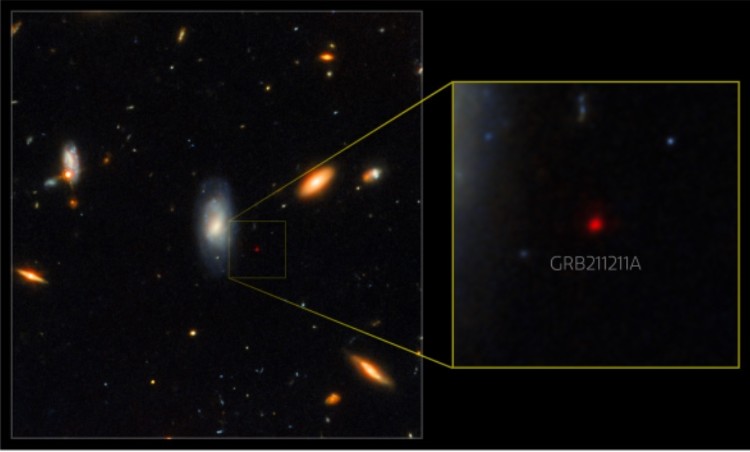[Image Credit: Illustration: CXC/M. Weiss; X-ray: NASA/CXC/UNH/D. Lin et al, Optical: CFHT. ] |
|
dy·nam·ics noun
1.
the branch of mechanics concerned with the motion of bodies under the action of forces.
2.
the forces or properties which stimulate growth, development, or change within a system or process.
"the dynamics of changing social relations"

What is dynamics in physics?
Dynamics is a branch of physics that examines the influences on the motion of an object. Physics examines the relationships between physical properties and forces and their manifestations in interactions between objects. The four main elements of dynamics are mass, energy, momentum, and force.Oct 4, 2022

What is the exact meaning of dynamics?
1. : the science of the motion of bodies and the action of forces in producing or changing their motion. 2. : physical, moral, or intellectual forces or the laws relating to them.
|
|
|

Institute for Gravitation and the Cosmos (IGC) - Penn State
|
| https://igc.psu.edu/topics/dynamic_universe/#:~:text=Many%20dynamic%20phenomena%20in%20the,the%20merger%20of%20neutron%20stars. |

Many dynamic phenomena in the universe occur over a period of seconds to years. Events with quickly evolving signals include the explosions of Type 1a supernovae, the destruction of stars passing too close to a black hole, and the merger of neutron stars. Some transient phenomena, like Type Ia supernovae, release light in such a reliable way that they can be used as standard reference events to study the evolution of the universe. Other events provide information about matter in extreme environments and at very high energies.

These phenomena may be observed not just through their electromagnetic emission, but also through the generation of particles or gravitational waves. For example, a merger of two neutron stars first detected as a gravitational wave event, GW170817, was subsequently observed across the electromagnetic spectrum. Fluctuations in the energetic matter streaming out from the vicinity of a black hole in the center of a galaxy, the flaring blazar TXS 0506+056, produced both neutrinos detected by IceCube and high-energy gamma rays. Several new instruments promise to bring an explosion of data for the study of transient phenomena in the universe.

|
|
| Credit: X-ray: NASA/CXC/Univ. of Nottingham/H. Russell et al.; Radio: NSF/NRAO/VLA; Image Processing: NASA/CXC/SAO/N. Wolk |
|
| In the center of this image is the quasar H1821+643, a rapidly growing supermassive black hole that astronomers have found is underachieving, despite producing intense radiation and a jet of particles seen in radio data from the Very Large Array (red). Located in the middle of a cluster of galaxies, H1821+643 is surrounded by huge quantities of hot gas detected in X-rays by Chandra (blue). The high temperatures and densities of the hot gas around the quasar shows that the black hole is having a weaker impact on its host galaxy than many of its other counterparts in other galaxy clusters. H1821+643 is the closest quasar to Earth in a cluster of galaxies. It is located 3.4 billion light-years from Earth and the image is about a million lightyears across at the distance of the quasar. |
|
|

|
NASA’s Chandra identifies a Black Hole Whose Bark is Worse Than Its Bite.
| _ 2024-03-21 by Penn State Science News & ICG _ |
Author: Niel Brandt, Eberly Family Chair Professor of Astronomy and Astrophysics, Professor of Physics
|
 
|
The quasar produces high levels of radiation and powerful jets, but it has less influence on its surroundings than expected. 21 March 2024

Astronomers have revealed that a brilliant supermassive black hole is not living up to expectations. Although it is responsible for high levels of radiation and powerful
jets, this giant black hole is not as influential on its surroundings as many of its counterparts in other galaxies.

A paper describing these results, by a team including W. Niel Brandt, the Eberly Family Chair Professor of Astronomy and Astrophysics and professor of physics at Penn State, appeared in the Monthly Notices of the Royal Astronomical Society.

The study, using data from NASA’s Chandra X-ray Observatory, looked at the closest quasar to Earth. Known as H1821+643, this quasar is about 3.4 billion lightyears from Earth and sits in a cluster of galaxies. Quasars are a rare and extreme class of supermassive black holes that are furiously pulling material inwards, producing intense radiation and sometimes powerful jets.
"I have long desired to investigate this remarkable quasar better with Chandra's keen eyesight," Brandt said. "I suspected this quasar's `bark' would be worse than
its `bite' — that is, its impressive pyrotechnics do not imply similarly impressive environmental impact. I'm delighted that our dogged determination eventually
paid off and confirmed my suspicions!”

Most growing supermassive black holes pull material in less quickly than quasars. Astronomers have studied the impact of these more common black holes by observing ones in the centers of galaxy clusters. Regular outbursts from such black holes prevent the huge amounts of superheated gas they are embedded in from cooling down, which limits how many stars form in their host galaxies and how much fuel gets funneled toward the black hole. Much less is known about how much influence quasars in galaxy clusters have on their surroundings.

“We have found that the quasar in our study appears to have relinquished much of the control imposed by more slowly growing black holes,” said Helen Russell of
the University of Nottingham in the United Kingdom, who led the new study. “The black hole’s appetite is not matched by its influence.” To reach this conclusion, the team used Chandra to study the hot gas that H1821+643 and its host galaxy are shrouded in. The bright X-rays from the quasar, however, made it difficult to study the weaker X-rays from the hot gas. “We had to carefully remove the X-ray glare to reveal what the black hole’s influence is,” said co-author Paul Nulsen of the Center for Astrophysics, Harvard and the Smithsonian. “We could then see that it’s actually having little effect on its surroundings.”

The team found that the density of gas near the black hole in the center of the galaxy is much higher, and the gas temperatures much lower, than in regions farther away. Scientists expect the hot gas to behave like this when there are little or no sources of energy — typically outbursts from a black hole — to prevent the hot gas from cooling down and flowing towards the center of the cluster.

“The giant black hole is generating a lot less heat than most of the others in the centers of galaxy clusters,” said co-author Lucy Clews of the Open University in
the U.K. “This allows the hot gas to rapidly cool down and form new stars, and also act as a fuel source for the black hole.”

The researchers determined that hot gas equivalent to about 3,000 times the mass of the sun per year is cooling to the point that it is no longer visible in X-rays. This
rapid cooling can easily supply enough material for the 120 solar masses of new stars observed to form in the host galaxy every year, and the 40 solar masses consumed by the black hole each year.

The team also examined the possibility that the radiation from the quasar is directly causing the cluster’s hot gas to cool down. This involves photons of light from the quasar colliding with electrons in the hot gas, causing the photons to become more energetic and the electrons to lose energy and cool down. The team’s study showed that this type of cooling is probably occurring in the cluster
containing H1821+643 but is much too weak to explain the large amount of gas cooling seen.

“While this black hole may be underachieving by not pumping heat into its environment, the current state of affairs will likely not last forever,” said co-author
Thomas Braben of the University of Nottingham. “Eventually the rapid fuel intake by the black hole should increase the power of its jets and strongly heat the gas.
The growth of the black hole and its galaxy should then drastically slow down.”

Brandt’s work on the project was supported by the Penn State Eberly Family Chair in Astronomy and Astrophysics and the Chandra X-ray Center.
Editor’s note: A version of this story appeared on the Chandra X-ray Center
website.
|

|
|
12/19/22, 4:27 PM Rare cosmic explosion blasts hole in established science | Eberly College of Science https://science.psu.edu/news/rare-cosmic-explosion-blasts-hole-in-established-science 1/3 News Events Alumni Faculty and Staff Directory 8 December 2022 While studying the aftermath of a long gamma-ray burst (GRB), two independent teams of astronomers using a host of telescopes in space and on Earth, including the Gemini North telescope on Hawai‘i and the Gemini South telescope in Chile, have uncovered the unexpected hallmarks of a kilonova, the colossal explosion triggered by colliding neutron stars.
Credit: NOIRLab/NSF/AURA/J. da Silva/Spaceengine |
|
|


|
While studying the aftermath of a long gamma-ray burst (GRB), two independent teams of astronomers using a host of telescopes in space and on Earth, including the Gemini North telescope on Hawai‘i and the Gemini South telescope in Chile, have uncovered the unexpected hallmarks of a kilonova, the colossal explosion triggered by colliding neutron stars.

Credit: NOIRLab/NSF/AURA/J. da Silva/Spaceengine
On Dec. 11, 2021, the NASA’s Neil Gehrels Swift
Observatory, which has its Mission Operations Centerat Penn State, detected a blast of high-energy light from
a galaxy roughly 1 billion light-years away. The event,
which was simultaneously detected by Fermi Gamma-
ray Space Telescope, brings into question what was
thought to be settled science concerning gamma-ray
bursts (GRBs), the most energetic explosions in the
universe.

“It was something we had never seen before,” said
Simone Dichiara, assistant research professor of
astronomy and astrophysics at Penn State and member
of the Swift team. “We knew it wasn’t associated with a
supernova, the death of a massive star, because it was
too close. It was a completely different kind of optical
signal, one that we associate with a kilonova, the explosion triggered by colliding neutron stars.”

The Swift team was able to rapidly identify the explosion’s location, in the constellation Boötes,
enabling other facilities to quickly respond with follow-Gamma-ray bursts come in two varieties: long and short. Scientists previously understood long GRBs, which last a couple of seconds to one minute, as forming when a super massive star explodes as a supernova. Short GRBs, which last less than two seconds, were previously thought to only occur when two compact objects — like two neutron stars or a neutron star and a black hole — collide to form a kilonova.

The revelation that a kilonova could trigger a long gamma-ray burst rewrites the decades-long paradigm of cosmic explosions: that long GRBs are strictly the signature of the death of massive stars, Dichiara explained. The discovery means not all long GRBs are made by supernovae, some are produced by the merger of neutron stars.

|

| This composite Gemini North and Hubble shows the telltale near-infrared afterglow of a kilonova produced by a long GRB. This discovery challenges the prevailing theory that long GRBs exclusively come from supernovae, the end-of-life explosions of massive stars. Credit: International Gemini Observatory/NOIRLab/NSF/AURA/M. Zamani; NASA/ESA |

| “This event was a game-changer that showed to us how our well-established knowledge of the universe was in fact only a partial and incomplete view,” said Eleonora Troja, an astronomer at the University of Rome Tor Vergata and lead author on the paper. “This result was hard to digest at first and we spent months trying to figure out alternative explanations, but in the end this is the only one that works well. Although we have been studying GRBs for decades, it is awesome to see how the universe can surprise us in the most unexpected ways.” The work was supported by the European Research Council through the Consolidator grant BHianca and by the National Science Foundation. |

|
|

|

https://en.wikipedia.org/wiki/Dynamics


Dynamics (mechanics)
Aerodynamics, the study of the motion of air
Analytical dynamics, the motion of bodies as induced by external forces
Brownian dynamics, the occurrence of Langevin dynamics in the motion of particles in solution
File dynamics, stochastic motion of particles in a channel
Flight dynamics, the science of aircraft and spacecraft design
Fluid dynamics or hydrodynamics, the study of fluid flow
Computational fluid dynamics, a way of studying fluid dynamics using numerical methods
Fractional dynamics, dynamics with integrations and differentiations of fractional orders
Molecular dynamics, the study of motion on the molecular level
Langevin dynamics, a mathematical model for stochastic dynamics
Orbital dynamics, the study of the motion of rockets and spacecraft
Quantum chromodynamics, a theory of the strong interaction (color force)
Quantum electrodynamics, a description of how matter and light interact
Relativistic dynamics, a combination of relativistic and quantum concepts
Stellar dynamics, a description of the collective motion of stars
System dynamics, the study of the behavior of complex systems
Thermodynamics, the study of the relationships between heat and mechanical energy
Vehicle dynamics

|
|
|
|

![]()

